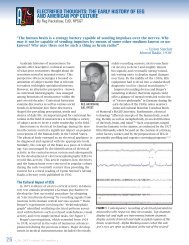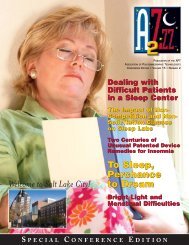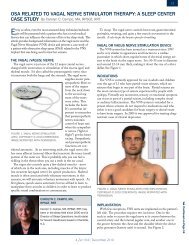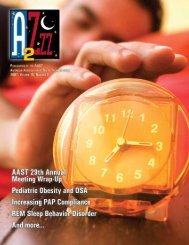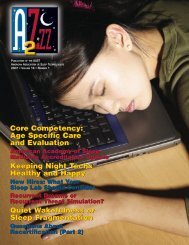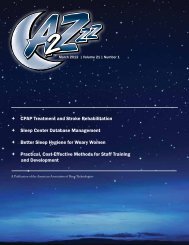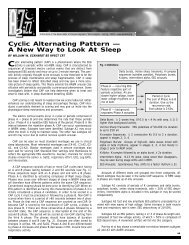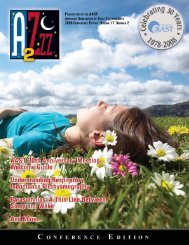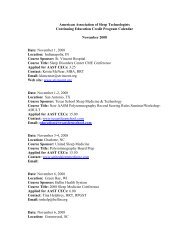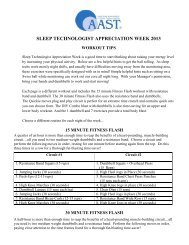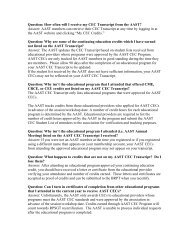APT Practice Parameter for Standard Polysomnography APT ...
APT Practice Parameter for Standard Polysomnography APT ...
APT Practice Parameter for Standard Polysomnography APT ...
- No tags were found...
Create successful ePaper yourself
Turn your PDF publications into a flip-book with our unique Google optimized e-Paper software.
Publication of the Association of Polysomnographic Technologists • 2006, Volume 15, Number 4 • www.aptweb.orgPathological YawningBY JOANNE HEBDING, RPSGT, ASSOCIATE EDITORWhen I was a child, my mother told me yawning was from a lackof oxygen, but I knew it was really from being bored. During mysearch <strong>for</strong> in<strong>for</strong>mation on yawning, I found out that Mom was right again!Excessive or pathological yawning, or “chasm,” is medically definedas a complex arousal reflex that arises from the brainstem and isthought to counteract hypoxemia in the brain. This action is not frombeing fatigued or bored.Our Sleep Center recently saw a 50-year-old woman who has beenfollowed <strong>for</strong> dymelinating disease <strong>for</strong> the last decade. She recently washospitalized <strong>for</strong> shortness of breath. Her yawning began during that hospitalizationalthough her demyelinating disease had not worsened. A cervicalspine magnetic resonance imaging (MRI) test, with and without contract,revealed signal alterations consistent with demyelinating pathology,especially at C2-3 and C3-4. The yawning has worsened in the lastseveral months.The phenomenon occurs throughout the day, and appeared todecrease during her sleep period. Her yawning is characterized by awide-open jaw extension that has become quite exhausting <strong>for</strong> her jaw.The patient does not complain of acute daytime hypersomnolence, andscored well within normal limits on the Epworth Sleepiness Scale score.She has difficulty initiating sleep due to muscular spasms, as well ascomplaints of maintaining sleep <strong>for</strong> no apparent reason. She has notedleg movements, as well as general body movements, but denied any legparesthesias, sleep paralysis, hypnagogic hallucinations or cataplexy. Noautomobile accidents were reported associated with drowsiness.Her neurologist ordered overnight polysomnography followed by amultiple sleep latency test (MSLT). Sleep efficiency on the polysomnograms(PSG) was reported at 78.5% with a non-rapid eye movementsleep (NREM) respiratory distress index(RDI) of 16.8. Oxygen desaturationswere reported with a nadir of 87%.Snoring was minimal. PLM arousal indexwas 0; however, 16 spontaneousarousals were reported. As per our splitprotocol, CPAP was initiated and titratedup to a maximal pressure of 7 cm. TheMSLT revealed a normal MLTS of 11.2(>10 normal) with no rapid eye movementsleep (REM) periods in 4 separateJoanne Hebdingnaps. The patient has reported a good response to continuous positiveairway pressure (CPAP). Trial dosage of levodopa (Sinemet) at10/100 mg every morning was recommended by the sleep diplomatewho interpreted the studies.Some of the known causes of pathological yawning include encephalitis,seizures, tumors of the fourth ventricle region, multiple sclerosis,progressive supranuclear palsy, electroconvulsive therapy and neurolepticwithdrawal. 1,2,3,4,5 Dopamine agonists, valproate overdose,imipramine, withdrawal from morphine and estrogen substitution mayalso induce pathological yawning. 6,7,8,9 PLMS has been reported withpathological yawning. 10Now every time I yawn, I remember my mom and wonder how shegot to be so smart! ★References1. Arai K, Kita K, Komiyanma A, Saeki N, Nagao KI (1986) Profressive dysautonomia inhemangioblastoma of the fourth venricle region. Brain Nerve 38: 195-2002. D’Mello, DA, Vincent FM, Lerner MP (1988) Yawning as a complication of electroconvulsivetherapy with concurrent neuroleptic withdrawal. J. Nerv Ment Dis 176: 188-189.3. Fletcher S, cohen F, Borenstein F, Regev I, Vardi J(1982) Yawning as a paroxysmal sign of diencephalicseizures. Arch Psychol Psychiatry Neurol 43; 45-544. Postert T, Pohlau D, Meyes S, Nastos I, Przuntek H(1996) Pathological yawning as a symptoms of multiplesclerosis. J.Neurol 243: 300-3015. Van Sweden B, Vanderhoven L, van Erp MG (1994)Excessive yawning. Acta Neurol Belg 94: 150-151.6. Goldberg RL (1983) Sustained yawning as a side effectof imipramine. Int J Psychiatry Med 13: 277-2807. Rollinson RED,Gilligan BS (1979) Post anoxic actionmyoclonus Lance Adams syndrome responding to valproate.Arch Neurol 36_44-458. Stahle L (1992) Do autoreceptors mediate dopamineagonist-induced yawning and suppressionof exploration?A critical view. Psychoparmacology 106:1-13.9. Van Sweden B,Vanderhoven L, van Erp MG (1994)Excessive yawning. Acta Neurol Belg 94:150-15110. Leonhardt M, Abele M, Klockgether T,Dichgans J, WellM (1999) Pathological yawning (chasm) associated withperiodic leg movements in sleep: cure by levodopa. J.Neurol 246; 621-622About the AuthorJoanne Hebding is <strong>APT</strong> Board Liaison to the <strong>APT</strong>Communications Committee and an associate editor <strong>for</strong>A2Zzz Magazine. A longtime sleep technologist and <strong>APT</strong>member, Hebding resides in Miami, Florida.30



